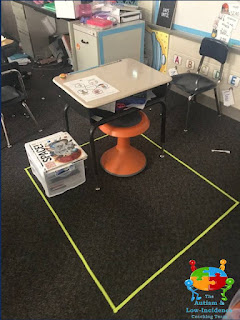Alternate Seating for Carpet Time
Some students struggle with where their body is in space or with the core strength needed to sit on the carpet for long periods of time. Alternate seating can be used to provide them with physical boundaries and sensory input to make carpet time more manageable.
 |
| Differentiated carpet time seating Molly Magoteaux Kleptz ELC, Northmont |
 |
| Differentiated carpet time seating Amy Beanblossom Arcanum Elementary, Arcanum |
 |
| Carpet time cars (how adorable!!) Pam Locker Washington Primary, Piqua |
 |
| Zuma Floor Rocker Kleptz ELC, Northmont |
Alternate Seating for Desk Work
For many of our students, desk work requires significant cognitive effort to sustain attention to the academic task. The ability to sustain this effort can be negatively impacted if student sensory needs are not met. Alternate seating is a great way to keep students engaged and on-task while still meeting sensory needs!
 |
| Foot rest for desk work Rylie Jarrett Stevenson Elementary, Mad River |
 |
| Hokki stool in student home base Stacey Rickmon Northmoor Elementary, Northmont |
 |
| Mini Hokki Stool for standing to work Demmitt Elementary, Vandalia-Butler |
 |
| Hokki Stool in student home base Ashley Fry Bradford Elementary, Bradford |
 |
| Bungee rolling chairs Sarah Vikan Schnell Elementary, West Carrollton |
 |
| Zuma rocker with bouncy band on desk legs Lindsay Hixson Charles Huber Elementary, Huber Heights |
 |
| Zuma Chair with arms Catherine Anderson Rushmore Elementary, Huber Heights |
Alternate Seating for Group Work
Just like during desk work times, group work times require significant cognitive effort. Additionally, there are increased social demands such as paying joint attention to peers, participating, and working collaboratively. Again, alternate seating can be a great way to meet sensory needs so that students are more equipped to meet group work expectations.
 |
| Mini Hokki Stools Demmitt Elementary, Vandalia-Butler |
 |
| Textured Peanut seats Nikki Tinnermann Kleptz ELC, Northmont |
Alternate Seating for Break Times
For some students, they may be able to manage in a typical school chair for seat work or group times, but after extended periods of time, they may need to physically reposition to provide a reset and get ready for the next activity. Providing alternate seating for use between activities or during breaks can provide this opportunity to reposition and reset.
 |
| Gamer chair Catherine Anderson Rushmore Elementary, Huber Heights |
 |
| Seating options Allysson Leapley Tipp High School, Tipp City |
 |
| Spin Discs Amy Pratt Springcreek Elementary, Piqua |
Alternate Seating Options
There is no one-size-fits-all approach to alternate seating. And what works for a student one day, may not be as effective the next day. We think it is wonderful when teachers provide a variety of alternate seating options for students to choose from.
 |
| Therapy ball, stool, stationary bike, gamer rocker, and beanbag seating options Allysson Leapley Tipp High School, Tipp City |
When providing alternate seating options, we highly recommend direct instruction and priming of expectations to ensure students use these seating options appropriately and when permitted. Check out our Top 3 Tips for ideas on implementation.



No comments:
Post a Comment